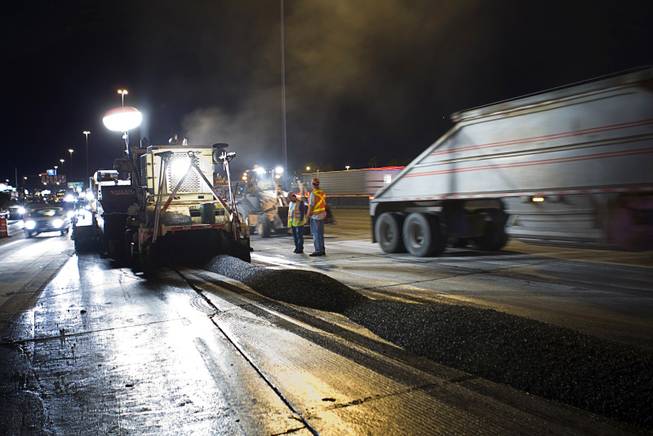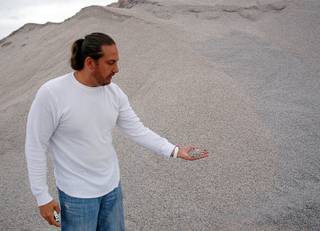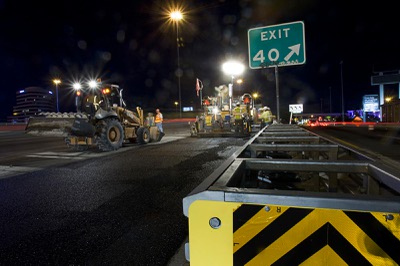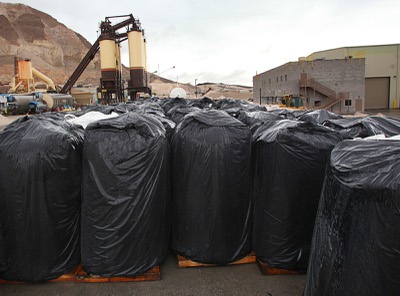
A shuttle buggy feeds rubberized asphalt into a paver during resurfacing of Interstate 15 between Tropicana Avenue and Charleston Boulevard Monday, Sept. 19, 2011.
Tuesday, Sept. 20, 2011 | 2 a.m.
Sun Archives
Sun Coverage
Kids play four square on it. Airplanes land on it. Cars drive and park on it. This being Las Vegas, we tell people we can fry eggs on it.
Asphalt is nearly everywhere, and seems to all be the same, but it won’t be the usual old blacktop we’re used to when the makeover of Nevada’s busiest freeway is complete.
The new road will be rubberized — maybe even with some of the very same rubber that was once in the tires that rumbled on Interstate 15.
About 450 tons of crumb rubber — old tires stripped of metal and pulverized into a substance that resembles coffee grounds — are being melted down, mixed with hot oil and lye and combined with rock and sand to make about 25,000 tons of asphalt.
That’s enough for a one-inch-thick layer on I-15 from Tropicana Avenue to the Spaghetti Bowl.
Similar asphalt was used a few years ago to repave a small stretch of U.S. 93 in Henderson, south of the Las Vegas Beltway. It has also been used on some local roads, including Green Valley Parkway.
But this is the first time it is being used on a major stretch of freeway in the state, and it couldn’t be a more important stretch.
I-15 sees far more traffic than any other road in the state. In July, the most recent data available, an average of 262,182 vehicles traveled daily on I-15 at the Sahara Avenue interchange.
Right now, the road is a mess. Years of wear and tear combined with markings left by construction projects have left the freeway full of bumps and cracks and made some lane markings almost invisible.
All that will be gone when the work is done.
The Nevada Transportation Department promises the temporary traffic headaches created by the repaving will be worth it.
“We expect people are going to ask for more of this (type of asphalt),” Project Manager Luis Garay said.
The rubberized asphalt is good for the environment since it takes tires out of landfills, and it has a number of advantages as a road surface, but when it comes down to it, it was the best way to resurface I-15 quickly and avoid even bigger traffic problems, department officials said.
The eight miles of I-15 being repaved are currently made of concrete, which hasn’t had any major resurfacing done in 15 years.
To replace the concrete would be expensive and require extensive lane closures. Covering the concrete with a new layer of asphalt will make the road look like new, without tearing out the old stuff first.
“We wanted to put something on the surface to make it a clean slate,” said Darin Tedford, a principle materials engineer.
To consider their options, Nevada officials went to Arizona, which first began using rubberized asphalt in the 1960s. More than 4.2 million tons of rubberized asphalt has been used there since 1988.
Tedford said Arizona has seen good success with the material.
Traditional asphalt has to be applied in thicker layers, but the rubberized version can be put down in a one-inch layer, Tedford said.
“So that’s basically the only tool for doing what we wanted to do on I-15,” he said.
The surface lasts about twice as long as traditional asphalt, provides good friction for vehicles and reduces splashing when the road is wet, he said.
The Transportation Department has been closely monitoring the section of U.S. 93 that has the rubberized asphalt, and has so far been pleased with the success.
The material wouldn’t work well in Northern Nevada because of the cold weather, which could lead to the asphalt breaking off the concrete when it freezes, Tedford said. It also doesn’t last long with chains and snow plows.
But it seems to be a perfect fit for Southern Nevada, although it has to be applied in the spring or fall when it’s warm but not too hot.
The high priority of paving I-15 quickly and successfully put pressure on the department to find a contractor who had experience with the material.
It turned to Fisher Sand & Gravel, which is based in North Dakota, but has done extensive work with rubberized asphalt in Arizona, where Tommy Fisher, the company president, lives.
The company has even built its own traveling equipment, two large pieces of machinery that can be hauled by semi-trailers to an existing asphalt plant to process the rubber.
The equipment has been set up at the Sloan Quarry south of Las Vegas, through an agreement with Aggregate Industries.
The rubber arrives in one-ton bags, is heated to 400 degrees and is mixed with oil, then pumped into Aggregate’s plant, which mixes it with sand and gravel to make the asphalt.
The final product is 90 percent rock and sand, 9 percent oil and rubber and 1 percent lye.
Fisher crews have spent the past two weeks rehabilitating the concrete on I-15 in preparation for the paving, which began in earnest Monday night.
Some of the approximately 100 employees working on the $6 million project were hired locally, but the crew doing the final paving came in from Arizona.
But Fisher’s advantages in the project don’t all come from the Grand Canyon State.
The company has been operating in Southern Nevada for seven years, though this is its largest road project in the area. But Fisher holds the record for receiving the largest road construction contract in state history. It is currently extending Interstate 580 between Reno and Carson City, a $393 million, six-year project.
That project is going well, Transportation Department officials said.
Fisher says the company benefits from the working relationship with the department.
“I think when you have the trust of the department as a contractor, it makes things nice,” Fisher said.
The contract for the I-15 project says the work has to be done in six weeks, but if it is done early, the company gets a $1 million incentive bonus.
However, Tommy Fisher says he isn’t trying to do a quick job for the extra pay; the project is also about saving his reputation.
In 2009, Fisher submitted the lowest bid to Clark County for a project to widen the Las Vegas Beltway in the northwest valley, but county commissioners awarded the contract to Las Vegas Paving instead, saying Fisher’s bid was not responsible.
Fisher sued the county, and a judge ordered the contract be awarded to Fisher. After two years of fighting, Fisher, Las Vegas Paving and the county agreed on a settlement in June, giving Fisher about $5 million, but leaving Las Vegas Paving in control of the project.
The public legal battle was damaging to Fisher Sand & Gravel, with county commissioners airing the company’s dirty laundry as they sought to award the project to Las Vegas Paving.
Fisher says the I-15 project is going to restore his reputation.
“At the end, we hope to provide a good product and hopefully this is a good product for the whole community,” Fisher said. “If it gets done quickly and people like the result, they’ll see Fisher as a good company.”
Plus, the project is proof that the company can play with its competitors, he said. The I-15 project is reliant on Aggregate Industries to help with the pavement production.
Fisher is also currently working on U.S. 93 in Boulder City, a project for which Las Vegas Paving is a main supplier.
“There’s competition, but we’re still people” and can work together, Fisher said.





Join the Discussion:
Check this out for a full explanation of our conversion to the LiveFyre commenting system and instructions on how to sign up for an account.
Full comments policy